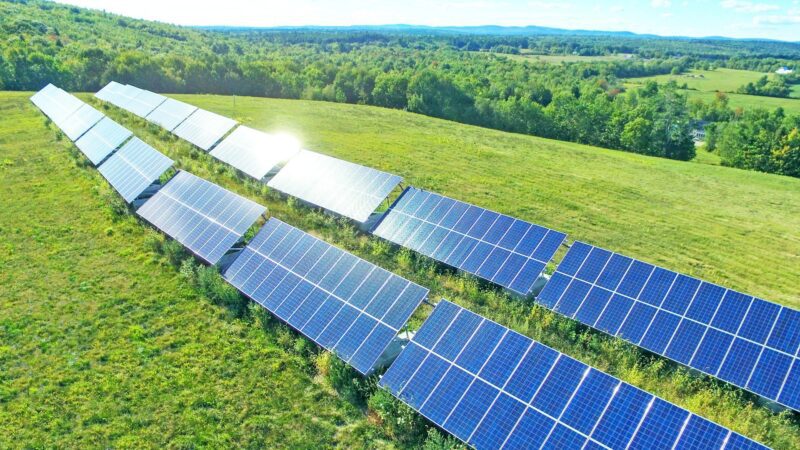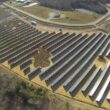Solar panels were installed behind trees, covered with snow, shaded by a barn or not tilted toward the sun.
Wind turbines were blocked by trees or shut down for safety reasons and then not turned back on when the wind was strong.
Heat pumps were turned off by homeowners because they were too noisy.
These are some of the findings in a study of a $1.1 million federal Department of Health and Human Services grant to the Maine State Housing Authority. The grant paid for installing alternative energy systems in the homes of low-income Mainers with the assistance of community action programs (CAPS).
The report and associated documents including emails were obtained through a Freedom of Access Act request by the Maine Center for Public Interest Reporting.
The alternative energy systems were installed, operated and tested in 80 homes and one apartment complex in Kennebec, Knox, Penobscot, Hancock and Washington counties between 2005-2008 under a federal program designed to reduce energy costs for qualifying families.
Part of the grant included $75,000 for a technical evaluation of the program by Joseph Associates, Inc. of Hallowell.
That evaluation concludes that the program “does in fact make a significant contribution in helping to empirically sort through a rather broad range of alternative measures by ranking each according to their energy savings and cost-effectiveness as derived from field testing.”
But the evaluation also states that ranking was not the primary purpose of the grant — the primary purpose was to “reduce energy costs of participating households.”
And the details of the report conclude that in all but one of the five alternative systems put in the homes of poor families the energy use — primarily electricity — went up, or down too little, to justify the cost of the new energy systems.
Dale McCormick, the director of MSHA, said at the time the alternative energy systems were being installed, public housing was in crisis because of high oil prices.
“We could have managed, monitored this better … but all hell was breaking loose, it was $4.50 a gallon and we were in crisis, as was the whole world.”
Solar hot water heaters
To help poor families save on electricity and heating oil, MSHA contracted with a vendor to install solar panels to heat hot water at 10 homes, from Belgrade to Rockland. (The names of the recipients are not revealed by MSHA because most are receiving public assistance.)
Each installation cost $7,500.
Of the 10, the report found six were poorly installed, including one where the solar panels were put in upside down; four where the panels were not oriented properly toward the sun: and one where trees blocked the panels.
The study also analyzed the cost-effectiveness of the various alternative energy sources. These were determined by the Saving Investment Ratio (SIR). A ratio of less than one means that the new systems would never save enough in energy use to pay back the investment during its useful lifetime.
Only two of the 10 solar installations had an SIR of one or better. Five had less than one and two others could not be measured because the proper data was not collected by the vendors.
In half of the households, energy use increased while the panels were in use.
“The quality of many of the solar hot water installations did not meet industry standards,” the report states.
In a Belgrade home where panels were installed, the study said, “As of Oct. 1, the panels appear not to be producing any energy as they may have lost glycol,” the antifreeze that is an essential part of such solar heating systems.
The family in that home told the study authors that snow had built up for two months on the panels.
In Warren, the report states, “This installation was closest to ideal,” and had reduced energy use.
But a Franklin family told the study authors the installation was “sloppy.”
“When the (Franklin) client pointed out that the panels were not pointing at the sun a good part of the day, she was told that if she wanted a rack to re-orient the panels that it was her responsibility,” the report states.
The Clinton family in the program reported that the holes for the solar pipes were drilled too large, allowing bats to enter their home.
In Union, the report said, “There is a barn that shadows the units part of the day.”
The study rated the quality of each solar installation on a 1-10 scale. The average was 5.3. Of the 10, only one was rated as having “acceptable results.”
McCormick said the solar installations were “shocking.”
The contractor, now out of business, had been reliable on previous projects, she said, but in this case “he got overextended.”
Basement hot water heat pumps
The basement hot water heat pump, which is designed to use less energy than conventional hot water heaters, was the only technology installed by the program that showed a positive return on the investment.
Its return on investment ratios ranged from 2 to 5, well past the minimum of 1, demonstrating that it more than paid for itself during the life of the product.
MSHA installed 58 of the pumps in homes in Kennebec and Hancock counties. That accounted for 67 percent of all the installations made.
But because the basement heat pumps were the cheapest item — $750 each — they accounted for only 12 percent of the $351,000 spent on the purchase of all the different types of equipment.
“As a group, the BHWHP (basement hot water heat pump) installations were well designed and well implemented with some exceptions,” states the report.
If consumers could buy a pump for $700, they could be paid back from the energy savings in six years.
That finding was based on checking the energy usage where the pumps were installed, but the report tempers that finding by stating the “wide variation in the savings rates” in the (electric) “billing data is disappointing,” which “reduced our ability to accurately predict future savings.”
Overall, McCormick said the basement pumps “were the big winner” and are an example of the value of the program because it demonstrated for the state and federal energy assistance programs an alternative technology that can be cost effective in the homes of low-income families.
Cold water and all-climate heat pumps
MSHA installed 15 cold-climate heat pumps and two all- climate heat pumps for an average equipment cost of about $9,600 each.
Cold-climate and all-climate heat pumps work by removing heat from surrounding air and compressing it for use in heating hot water. They use less energy than conventional hot water heaters.
In the two homes where systems were installed to measure the effectiveness of cold-climate heat pumps, the report states: “ … unfortunately, the home owners turn(sic) the units off because they believed the units would not decrease their electric bill and they found the units very noisy.”
“Clearly, the CCHP (cold climate heat pumps) did not result in anticipated savings,” the report concludes.
The findings were not better for the one all-climate heat pump that was monitored: The payback period for the $10,000 device based on the modest energy savings it produced was 23 years.
Wind turbines
“None of the wind turbine installations resulted in SIRs greater than one,” the report concluded, meaning the energy savings from the three installed turbines was too little to pay off the cost of the installation over their useful life.
A small wind turbine was installed at an apartment complex in Winter Harbor at a cost of $65,000. In the best-case scenario, the payback period was 23 years; the worst case, 83 years.
The problem wasn’t with the installation — it was “well executed” according to the study.
The problem was with its operation.
The report states: “The turbine is designed to turn away from the wind and shut down during strong gusts. This is a safety measure. However, this caused a loss of potential production because it required a manual reset and the site is not serviced by on-site maintenance. At times it was over two weeks before the maintenance service arrived to check on the equipment. This problem is particularly troublesome because the shut-down often takes place during period of stronger winds and higher production potential.”
Additionally, two wind turbines of a different design were installed at homes. Each cost $12,500.
“At both locations,” states the report, “the units were located where their performance was limited by inconsistent winds and disturbance by nearby terrain, buildings or trees. In one location, the SkyStream is located in a low, bowl-like area.”
“Clearly, this is not a cost effective solution,” the study concluded.
Management problems
The study found problems not only with most of the installations, but also with the management of the $1.1 million program.
The initial plan was to have the program managed by the Community Action Programs in Kennebec and Washington-Hancock counties.
“CAPS,” as they are widely known, are non-profit agencies funded by federal, state and local governments to provide services to low-income families.
The Joseph report concluded the project was “beyond the scope” of MSHA, adding “all levels of management (MaineHousing, CAP agencies and MaineHousing contractors) had very little experience implementing these new technologies … The strategy of keeping overhead low by using existing staff and processes at all levels combined with the complexity of these six technologies proved ineffective.”
Responding to that critique, McCormick said, “We’re in the real world here … with CAPS that have the level of expertise that they have, with low-income families that have the needs and issues that they have … it’s a different world and we found out that some work and some don’t.”
Jo-Ann Choate, national policy advisor at MSHA who oversaw the REACH grant, said, “This has been the toughest” program she has had to administer.
McCormick said the alternative energy grant was not typical of her agency.
“We don’t have many like this,” she said.
Pat Kosman, executive director of the Kennebec Valley CAP, said, “I know there was difficulty with some of this … It was a learning curve. We’re probably better now than we were then.”
McCormick said all the equipment is still in place and the agency hopes to find the money to make the necessary repairs.
“We’re going to fix our mistakes,” she said. ‘We can get them up and working again.”
Despite the problems with all but one of the technologies, Joseph said the program was worth the effort and expense.
“Oftentimes when mistakes are made very important lessons are learned.” he said, “and a lot of important lessons were learned regarding the importance of the installation process.”




